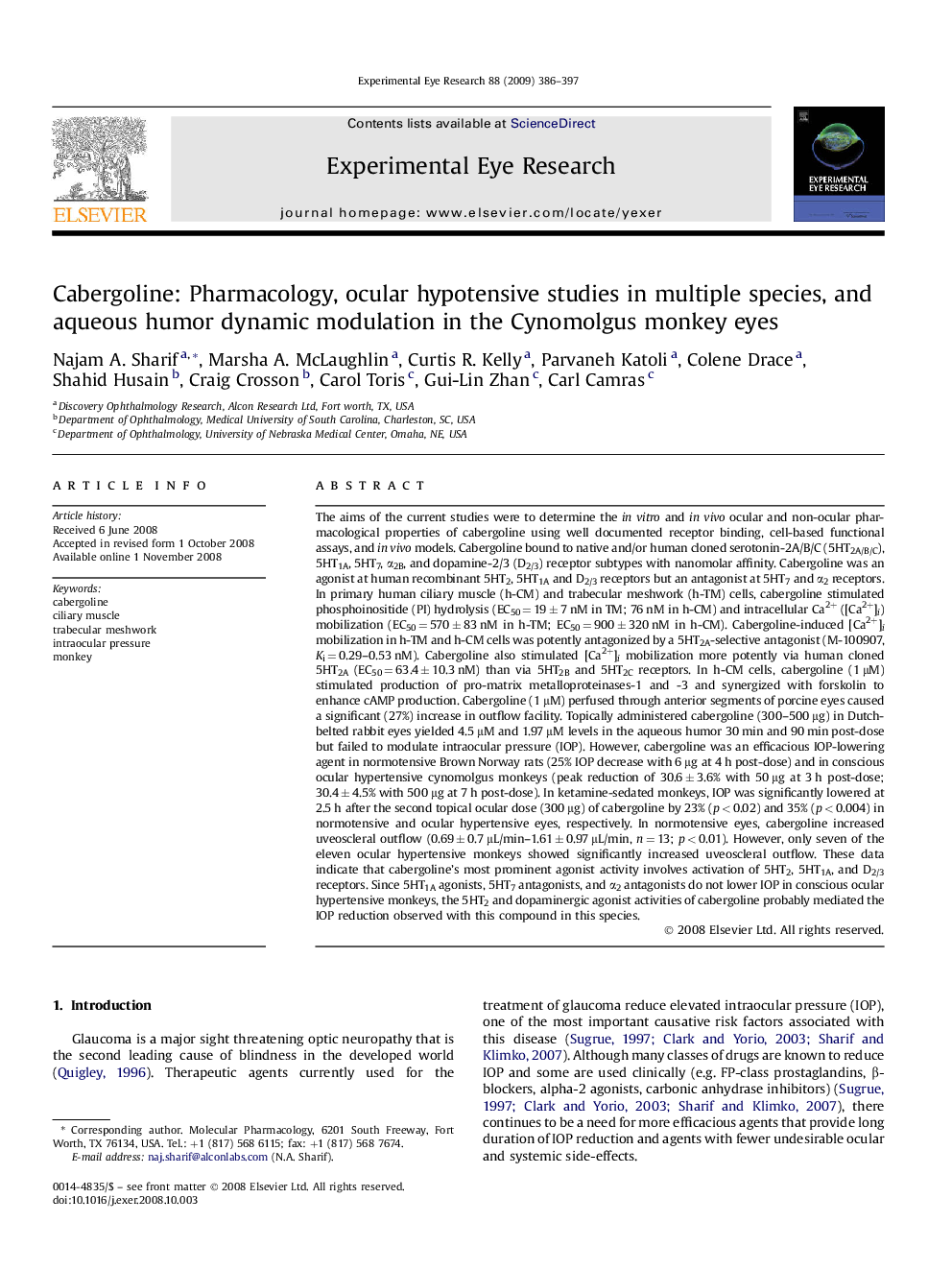| کد مقاله | کد نشریه | سال انتشار | مقاله انگلیسی | نسخه تمام متن |
|---|---|---|---|---|
| 6197506 | 1261174 | 2009 | 12 صفحه PDF | دانلود رایگان |

The aims of the current studies were to determine the in vitro and in vivo ocular and non-ocular pharmacological properties of cabergoline using well documented receptor binding, cell-based functional assays, and in vivo models. Cabergoline bound to native and/or human cloned serotonin-2A/B/C (5HT2A/B/C), 5HT1A, 5HT7, α2B, and dopamine-2/3 (D2/3) receptor subtypes with nanomolar affinity. Cabergoline was an agonist at human recombinant 5HT2, 5HT1A and D2/3 receptors but an antagonist at 5HT7 and α2 receptors. In primary human ciliary muscle (h-CM) and trabecular meshwork (h-TM) cells, cabergoline stimulated phosphoinositide (PI) hydrolysis (EC50 = 19 ± 7 nM in TM; 76 nM in h-CM) and intracellular Ca2+ ([Ca2+]i) mobilization (EC50 = 570 ± 83 nM in h-TM; EC50 = 900 ± 320 nM in h-CM). Cabergoline-induced [Ca2+]i mobilization in h-TM and h-CM cells was potently antagonized by a 5HT2A-selective antagonist (M-100907, Ki = 0.29-0.53 nM). Cabergoline also stimulated [Ca2+]i mobilization more potently via human cloned 5HT2A (EC50 = 63.4 ± 10.3 nM) than via 5HT2B and 5HT2C receptors. In h-CM cells, cabergoline (1 μM) stimulated production of pro-matrix metalloproteinases-1 and -3 and synergized with forskolin to enhance cAMP production. Cabergoline (1 μM) perfused through anterior segments of porcine eyes caused a significant (27%) increase in outflow facility. Topically administered cabergoline (300-500 μg) in Dutch-belted rabbit eyes yielded 4.5 μM and 1.97 μM levels in the aqueous humor 30 min and 90 min post-dose but failed to modulate intraocular pressure (IOP). However, cabergoline was an efficacious IOP-lowering agent in normotensive Brown Norway rats (25% IOP decrease with 6 μg at 4 h post-dose) and in conscious ocular hypertensive cynomolgus monkeys (peak reduction of 30.6 ± 3.6% with 50 μg at 3 h post-dose; 30.4 ± 4.5% with 500 μg at 7 h post-dose). In ketamine-sedated monkeys, IOP was significantly lowered at 2.5 h after the second topical ocular dose (300 μg) of cabergoline by 23% (p < 0.02) and 35% (p < 0.004) in normotensive and ocular hypertensive eyes, respectively. In normotensive eyes, cabergoline increased uveoscleral outflow (0.69 ± 0.7 μL/min-1.61 ± 0.97 μL/min, n = 13; p < 0.01). However, only seven of the eleven ocular hypertensive monkeys showed significantly increased uveoscleral outflow. These data indicate that cabergoline's most prominent agonist activity involves activation of 5HT2, 5HT1A, and D2/3 receptors. Since 5HT1A agonists, 5HT7 antagonists, and α2 antagonists do not lower IOP in conscious ocular hypertensive monkeys, the 5HT2 and dopaminergic agonist activities of cabergoline probably mediated the IOP reduction observed with this compound in this species.
Journal: Experimental Eye Research - Volume 88, Issue 3, March 2009, Pages 386-397